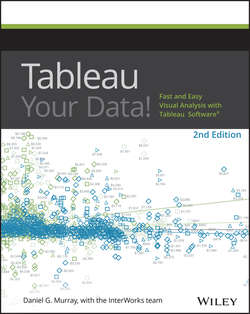Читать книгу Tableau Your Data! - Murray Daniel G. - Страница 9
На сайте Литреса книга снята с продажи.
Part I
Desktop
Chapter 1
Creating Visual Analytics with Tableau Desktop
The Shortcomings of Traditional Information Analysis
ОглавлениеEntities are having difficulty getting widespread usage of traditional BI tools. A recent study by the Business Application Research Center (BARC, 2009) reported adoption rates are surprisingly low.4
In any given BI using organization just over 8 percent of employees are actually using BI tools. Even in industries that have aggressively adopted BI tools (e.g., wholesales, banking, and retail), usage barely exceeds 11 percent.
Nigel Pendse, BARC
In other words, 92 percent of the people who have access to traditional BI tools don’t use them. The BARC survey noted these causes:
• The tools are too difficult to learn and use.
• Technical experts were needed to create reports.
• The turnaround time for reports is too long.
Companies that have invested millions of dollars in BI systems are using spreadsheets for data analysis and reporting. When BI system reports are received, traditional tools often employ inappropriate visualization methods. Stephen Few has written several books that illuminate the problem and provide examples of data visualization techniques that adhere to best practices. Stephen also provides examples of inappropriate visualizations provided by legacy vendor tools.5 It turns out that the skills required to design and build database products are different from the skills needed to create dashboards that effectively communicate. The BARC study clearly indicates this IT-centric control model has failed to deliver compelling answers that attract users.
You want to make informed decisions with reliable information. You have to connect with a variety of data sources and may not know the best ways to visualize the data. Ideally, the tool used should automatically present the information using the best practices. Tableau has become a popular choice because it makes industrial-strength reporting, analysis, and discovery accessible to less-technical staff. During the last few years, information technology teams have started to embrace end-user empowerment because it provides a more efficient way to provide information, reduces request backlogs, and provides a toolset for leveraging the knowledge of constrained technical human resources.
4
Stephen Swoyer, “Report Debunks Business Intelligence Usage Myth,” http://tdwi.org/Articles/2009/05/20/Report-Debunks-BI-Usage-Myth.aspx?Page=1.
5
Stephen Few, Information Dashboard Design: The Effective Visual Communication of Data, Berkeley, California, (O’Reilly Media, Inc, 2006), 4.
